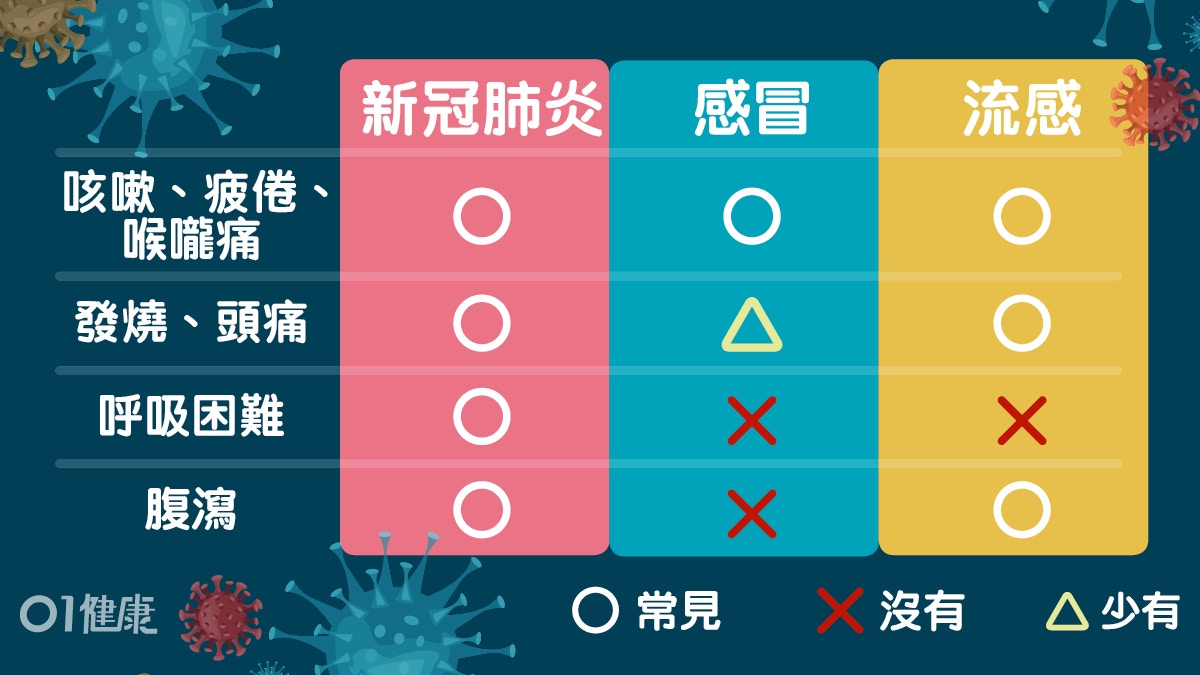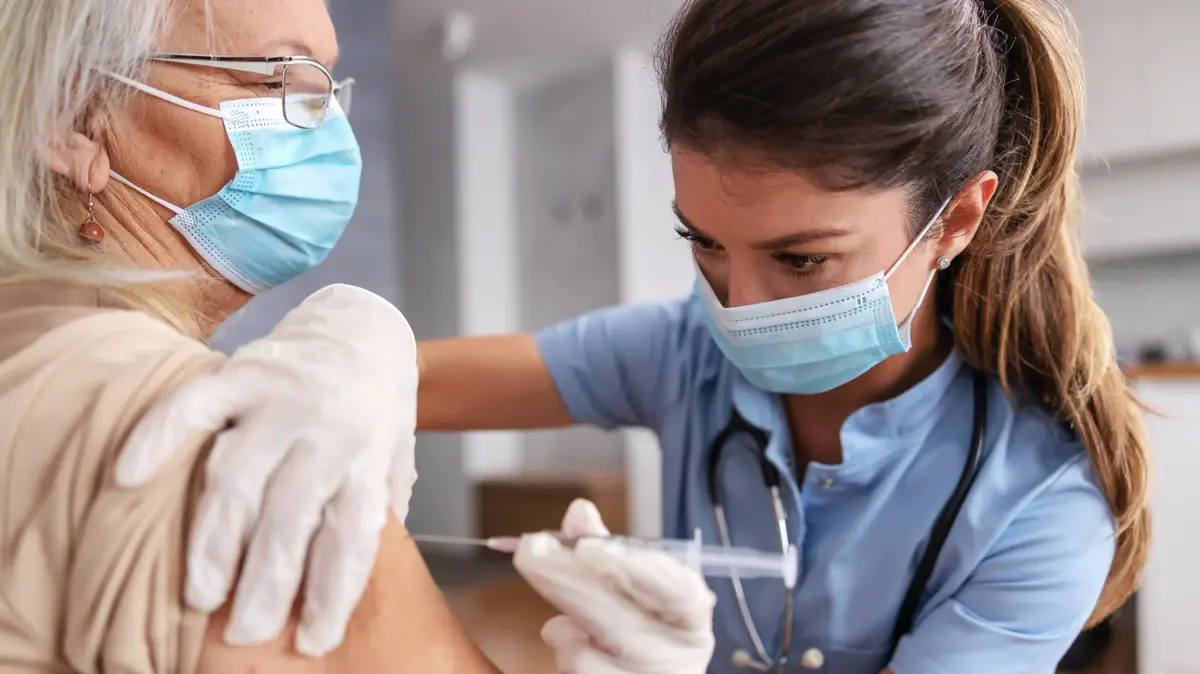health
Written by: Liao Qingxia
2020-07-21 13:45
Last update date: 2020-07-21 13:48The new crown pneumonia epidemic continues, local cases are on the rise, and there are many cases of unknown origin. The situation is worrying. Patients usually have fever, cough, fatigue and other symptoms. Many of the symptoms are similar to flu and colds, such as sore throat and cough. However, the flu usually resolves on its own within two to seven days, and the recovery time from a cold may be shorter . So if you have a fever, you are really infected by the new coronavirus. Do you need to be tested for the virus immediately? How can COVID-19 and influenza be distinguished?
Colds and flu are generally upper respiratory tract infections, while patients with new coronary pneumonia will have lower respiratory tract symptoms. Fever is a common symptom of new coronary pneumonia, but in fact, in addition to new coronary pneumonia, influenza, viral gastroenteritis, etc., can cause fever. What should I do if I suspect that I have a fever during the emergency? Is there anything to pay special attention to? (According to the picture):
+28
+27
+26
Key point 1: Confirm that you have a fever
Does a body temperature higher than 37°C mean fever? The body temperature location point is normally around 37°C. However, when an inflammatory reaction occurs in various diseases such as infection, the body temperature location point will rise, and the body will then have various physiological reactions leading to a rise in body temperature.
According to a CNN report, Dr. John Williams said that our body temperature will vary by about one to half a degree at different times. He advises everyone not to rely solely on the measurement results in the morning, but to take another measurement in the afternoon or dusk. The high level in the afternoon or evening is the common fever caused by the virus.
However, since the body temperature detected from different parts of the body will vary, the standards for fever will be different when using different heat detection methods. According to the Department of Health , the fever and body temperature indicators set by various heat detection methods are as follows (as shown in the picture):
+2
Oral detection: higher than 37.5°C, or higher than 99.5°F
Ear detection: higher than 38°C, or higher than 100.4°F
Anal detection: higher than 38°C, or higher than 100.4°F
Frontal probe: higher than 36℃, or higher than 96.8℉
Axillary detection: higher than 37.3°C, or higher than 99.1°F
Oral detection, ear detection, and anal detection are more accurate
In terms of accuracy, oral, ear, and anal probes measure the temperature of deep tissues, and there will be fewer errors; while axillary probes and frontal probes measure the surface temperature of skin tissues, which are easily affected by other factors, such as Just exercise, eating cold or hot food and drinks, etc., the accuracy is low, it is recommended to use it when oral, ear, and anal detection is not possible.
Related articles: [Fever] 37 degrees is equal to fever? Low body temperature increases the risk of cancer? 6 tips for taking body temperature
Point 2: Symptoms other than fever
Generally speaking, if it is suspected that the fever is due to body infection, first observe whether there is specific regional inflammation, such as inflammation, redness and swelling of gums, ears or skin; if not, observe whether there is hidden inflammation of internal organs (Such as liver, lung) symptoms.
The following are the symptoms of infectious diseases (according to the picture):
+7
+6
+5
1. Flu, cold: sore throat and runny nose often
According to the Department of Health, flu symptoms can include fever, cough, sore throat, runny nose, muscle pain, fatigue, and headache. The cough is more severe and lasts longer, but other symptoms usually subside within five to seven days. Colds have less fever and headaches.
2. New coronary pneumonia: there are lower respiratory symptoms
Common symptoms of new coronary pneumonia include fever, dry cough, sputum, and shortness of breath. They are similar to flu, but a study published in the medical journal "Needles" pointed out that one of the differences between the two is that pneumonia may have chest tightness and coughing. Lower respiratory tract symptoms such as pain behind the breastbone, wheezing when walking and talking, hot body, and easy feeling of cold.
Related articles: [New Coronary Pneumonia] Symptoms become milder and more covert
Some patients lose their sense of taste and smell. Some experts pointed out that respiratory viruses can impair the human body's ability to perceive odors, so it is common for people infected with the virus to lose their sense of smell. In addition to loss of taste or smell, some patients with new coronary pneumonia have rashes. The British "King's College London" survey found that 17% of diagnosed patients have rash as the first sign of infection with the new coronavirus; and 21% of those diagnosed even pointed out , Rash is their only symptom.
In addition, the World Health Organization lists unconsciousness or one of the symptoms of new coronary pneumonia, which may even appear before fever and cough. "CNN" reported that patients with the new crown may experience delirium or hallucinations, and may have long-term effects, including slow recovery, increased risk of dementia, depression or post-traumatic stress.
Other symptoms of new coronary pneumonia (click the picture):
+33
+32
+31
Related Articles: [New Coronary Pneumonia] Rash, Chills, Hallucinations, Symptoms Increased, 18 Symptoms Caused by New Coronavirus
The third point: should not be solved by anti-fever drugs alone
Many people will think of ways to reduce fever the first time they have a fever. There are many places where antipyretics are sold. However, family doctor Mo Kunyang pointed out that taking antipyretics is mainly to treat symptoms and make patients more comfortable. It has nothing to do with the disease itself. , Stressed that you still need to see a doctor to find out the cause of fever, there is no conflict between the two.
Doctor: The dosage is limited
However, Dr. Mo reminded you to pay attention to the dosage when taking antipyretics. "The most common antipyretic is Penicillin. Adults can only take 4 grams a day. One tablet of 500mg is 8 tablets. It should not exceed the standard."
Related articles: [Fever] How to distinguish infection with new coronary pneumonia? 5 key points to deal with fever, sweating aggravates the condition
Key 4: Patients with new coronary pneumonia may have sequelae
Although many patients with new coronary pneumonia have recovered and been discharged from hospital, even if patients with new coronary pneumonia "recover", they may not be cured like normal flu. They may have sequelae. The virus may attack different organs (as shown in the picture) :
+22
+21
+20
Influenza: less sequelae
Cold: no sequelae
New coronary pneumonia: permanent damage (such as pulmonary fibrosis)
The lungs of patients with new coronary pneumonia may be damaged or cause respiratory failure. However, even if the patient does not die, some people may suffer permanent lung damage that cannot be recovered. In addition, the liver may be injured, and this damage may be mild and recoverable, or it may be more serious damage such as liver failure.
Related articles: [Wuhan Pneumonia] Viruses attack body organs like SARS? Damage the lungs, liver, kidneys and stomach
Key five: patients with new crown may not be permanently immune
In addition, many people may think that if you have been infected with the new coronavirus, your body will produce antibodies and have immunity, but it is not accurate.
Influenza: have had the flu, or been vaccinated, have immunity
New coronary pneumonia: There has not been a similar virus before, humans have no immunity to it, and there is still no vaccine; there are also patients with Fuyang
Although there may be many flu patients in the community during the peak of the flu, some people may have been vaccinated before or have had the flu, so they have been immune to the flu, which limits the spread of the virus. On the contrary, before the emergence of the new coronavirus, the human immune system has never seen this virus, so no one can have natural immunity. This also means that everyone has a chance to be infected, and if the infected patient or the asymptomatic patient has contact with others, the virus may be spread, making the situation difficult to manage.
In addition, some patients with new coronary pneumonia "fuyang", that is, after being discharged from the hospital, the virus test was positive again. Therefore, after being infected with new coronary pneumonia or after being discharged from the hospital, it does not mean that you have immunity; as the new coronavirus mutates, the situation may change more. Everyone should prevent the epidemic and should not take it lightly.
Related articles: [New Coronary Pneumonia] The mortality rate is 10 times that of influenza! One article to understand 7 reasons more terrible than flu
King's College London (King's College London) published a research report on Monday (13th) that said patients with COVID-19 pneumonia may lose their immunity within a few months even if they develop antibodies in their bodies after they recover. According to the researcher, according to the report's conclusions, "herd immunity" may not be achieved at all.
Related articles:【New Coronary Pneumonia】It is difficult to recover from the infection and permanent immunity study: the antibody disappears within a few months
Related articles: [New Coronary Pneumonia] High risk of infection after rework? Past clinics? 37 high-risk rankings for daily activities
+18
+17
+16
[New Coronary Pneumonia] What is the difference in the risk of infection without wearing a mask? 4 tips for mask prevention
[New crown pneumonia] Rash, chills, hallucinations, more symptoms, 18 symptoms of new crown virus
[New Coronary Pneumonia] The high risk of infection after rework is in the clinic? 37 high-risk rankings for daily activities
[New Coronary Pneumonia] Virus mutation airborne can damage the brain and cause stroke. Harvard experts prevent 4 strokes
[New Coronary Pneumonia] Healthy young people may become seriously ill when their condition changes! With different levels of rehabilitation schedule
[New Coronary Pneumonia] Washing your hands and preventing the epidemic will not work if you wipe them dry! How many 12 common mistakes have you done?
New crown pneumonia new crown pneumonia epidemic prevention knowledge fever flu healthy living urban health









